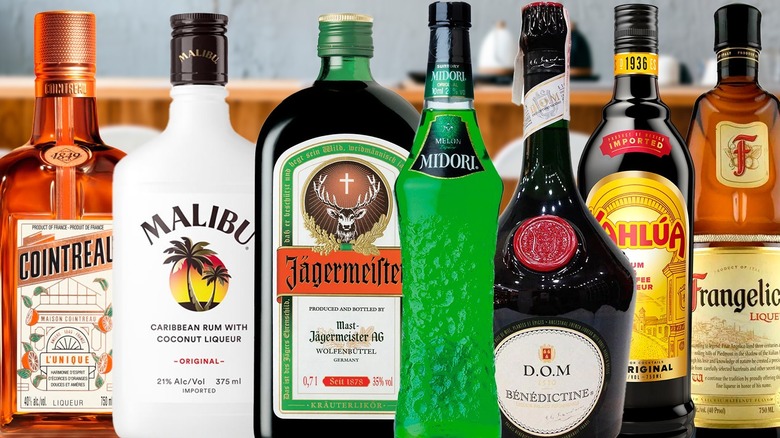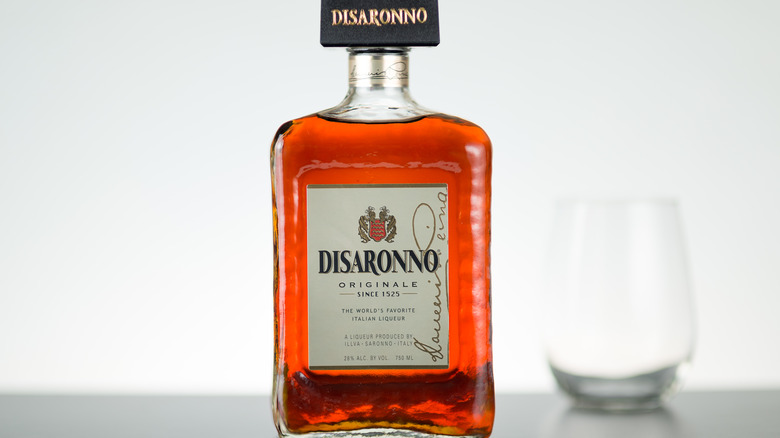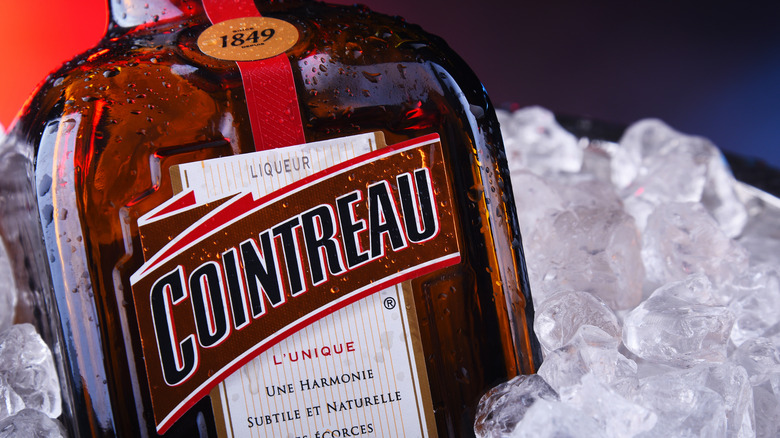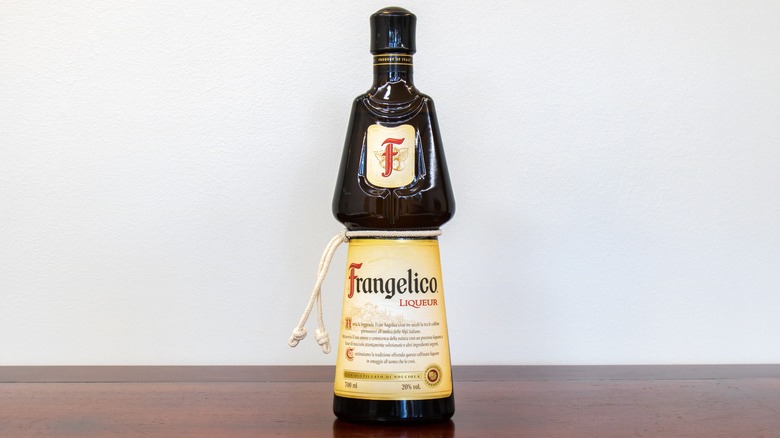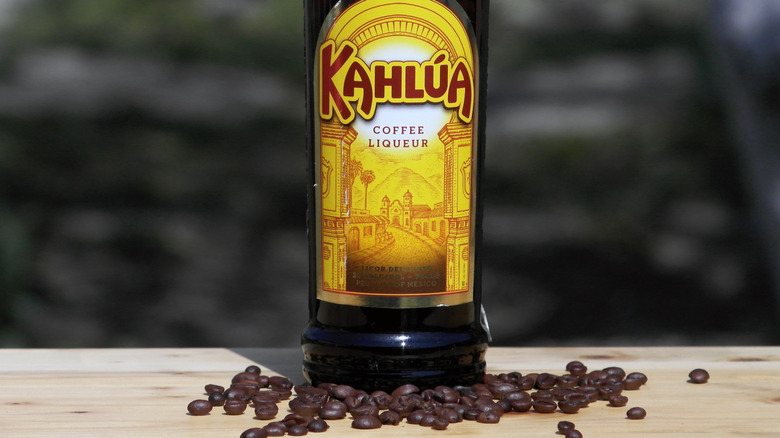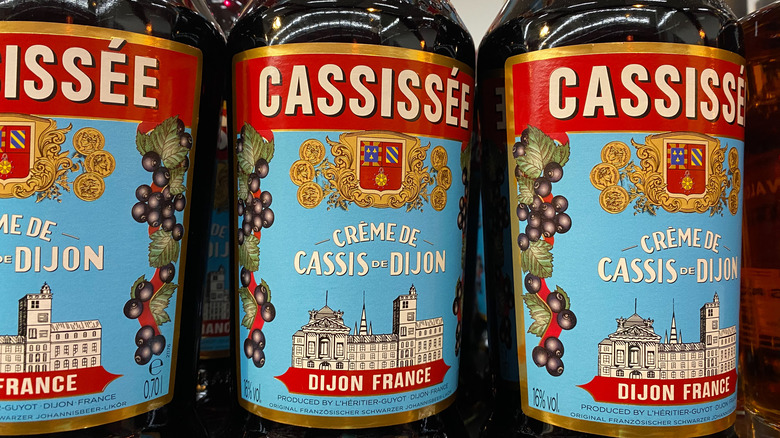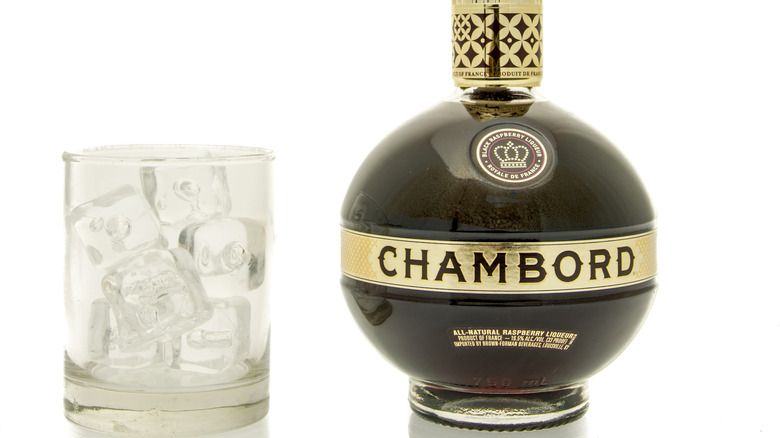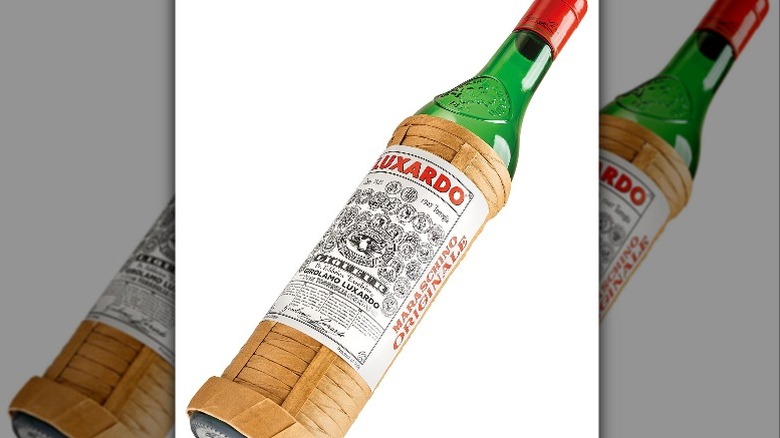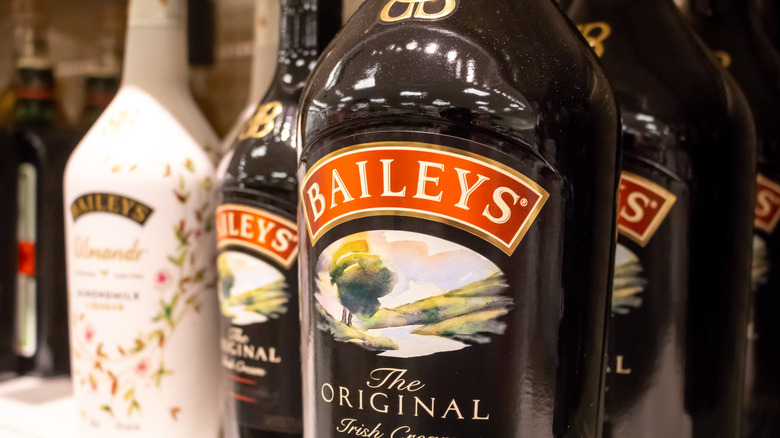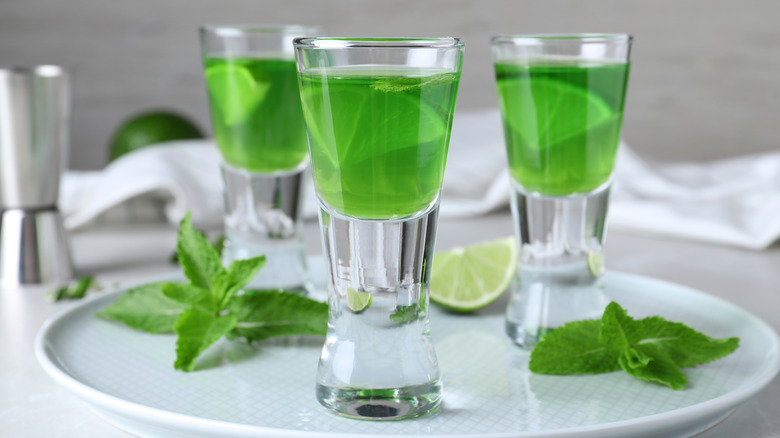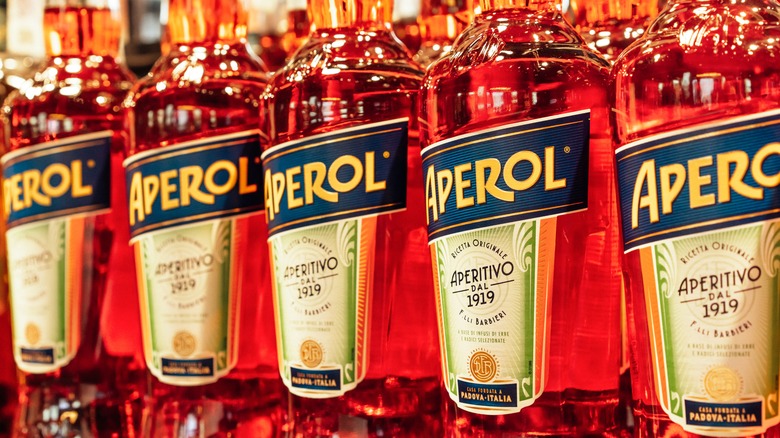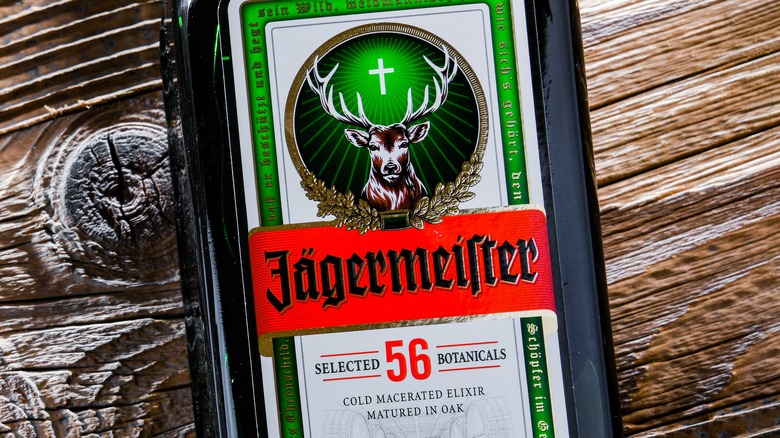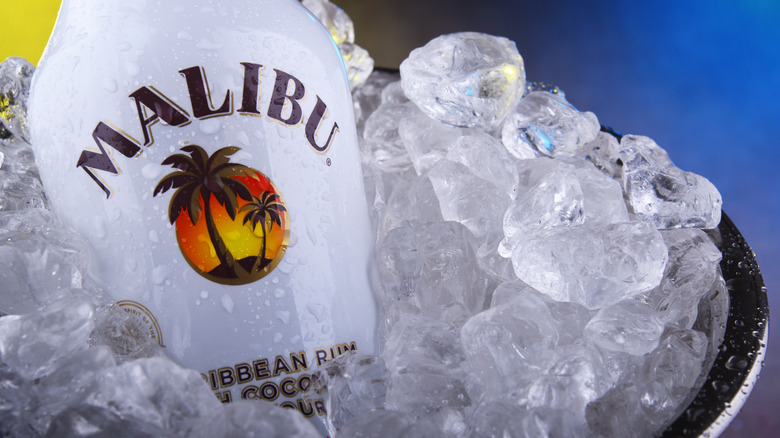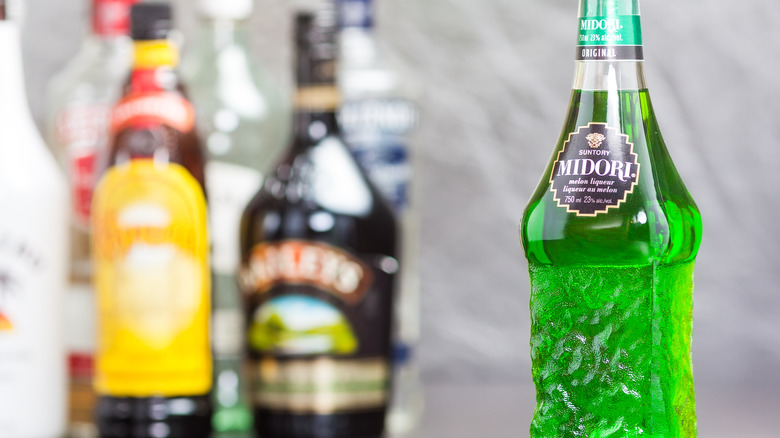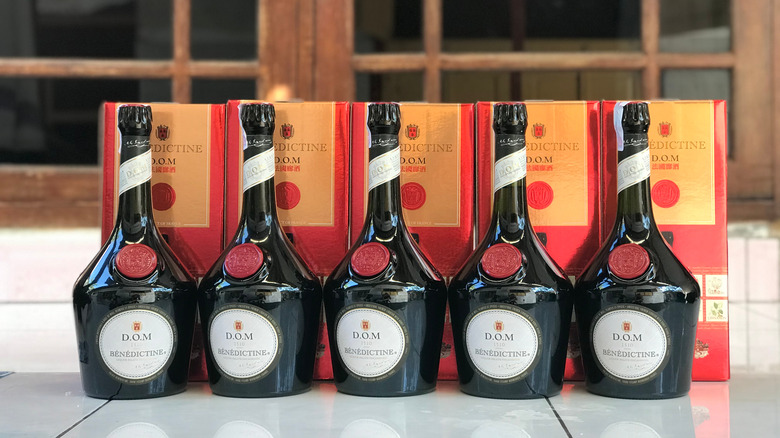14 Liqueurs To Keep Stocked In Your Home Bar
Kick off your shoes and get settled into that chair, folks. It's cocktail hour, and tonight, we're staying at home. Cocktails are one of the fanciest ways to enjoy an alcoholic beverage, and the act of mixing spirits and other drinks has been around for hundreds of years. Although there are actually only 77 "true" cocktails that are recognized by the International Bartender's Association, there's an argument to be made that if you have imagination and a few bottles of booze, you too can be an amateur mixologist.
But to make those wild and wacky cocktail creations — or to nail the classics — you're going to need liqueur. Classified as a spirit that's been flavored with additional ingredients like sugars, herbs, or fruits, liqueurs bring an essential component to cocktails, distinguishing them from run-of-the-mill drinks and making your mixed beverage a thing of beauty.
With that said, as anyone who's ever been in a well-stocked liquor store before knows, there are a lot of liqueurs out there. So how do you know which ones you need? With our essential guide, you can't go wrong. Let's take a look at the liqueurs you need to usher in happy hour without having to go to the bar.
Amaretto
Amaretto has a long and storied history as Italy's most-loved liqueur. Legend has it that the sweet drink was created in the early 16th century by a model enamored with Bernardino Luini, an acolyte of Leonardo da Vinci, to prove her love to him. As origin stories go, things don't get more glorious than that. The recipe was then passed down through the years until it was taken over by the Disaronno brand, arguably the most popular amaretto out there, whose signature rectangular bottles you can still find on shelves to this day.
Amaretto is traditionally a brandy-based liqueur, and while it has an almond-like scent and taste, it can also be made with apricot kernels. It gains additional notes from a selection of fruits and herbs and sweetness from burnt sugar, with the exact formulation being a heavily guarded secret in Disaronno's case. With a 28% ABV, Disaronno and other amarettos are traditionally drunk as a digestif. It's also frequently used as part of cocktails, and may be mixed with Coca-Cola or coffee for a boozy pick-me-up. A common way to enjoy amaretto is in an amaretto sour, which is made by combining amaretto and sour mix, served chilled or over ice.
Cointreau
If you've ever enjoyed a margarita, you've probably enjoyed Cointreau without even realizing it. Cointreau is part of a family of orange liqueurs, whose other members are triple sec, orange curaçao, and Grand Marnier. But this drink stands in a class of its own. Cointreau clocks in at 40% ABV, and comes in a distinctive rectangular bottle, with dark orange glass. Originating in the 19th century in France, it sports a distinctive citrus taste, with a slight acridity and spice to it that makes it way more complex than some other orange-based drinks.
The real reason you should have a bottle of Cointreau in your home bar, though, is because it's the key ingredient in a huge amount of cocktails. The aforementioned margarita is made by mixing tequila, Cointreau, and lime juice, with the orange liqueur cutting through the smokiness of the tequila to balance the drink's flavor notes. Cosmopolitans also feature Cointreau heavily, mixing the liqueur with vodka, cranberry juice, and lime for the ultimate party drink. The sidecar, Long Island iced tea, Mai Tai, Singapore sling, and white lady all have Cointreau mixed into them as well. Simply put, if you want to have a cocktail party, you're going to need a bottle of this in there.
Frangelico
If you're a lover of all things nuts, you'll be a big fan of Frangelico. This complex, nuanced liqueur is imbued with the flavor of toasted hazelnuts, with additional notes of coffee, vanilla, and chocolate tied together with syrup. Like many other liqueurs, the makers of Frangelico deliver their product in a distinctive bottle, shaped like a friar's cassock, which speaks to the legend of its creation by Franciscan monks. Honestly, we'd love to be a member of that monastery.
A 40-proof drink, Frangelico is the perfect alcoholic beverage for those who want a sweet digestif at the end of a meal. With an eminently drinkable base flavor, this is a drink that shines on its own and isn't too bitter to mix into cocktails. Having said that, mixing Frangelico into drinks can give a delightful twist to your favorite pre-dinner beverage. Adding half an ounce of Frangelico into a martini gives the drink a nutty edge, and can mellow the cocktail out somewhat. Alternatively, mixing lemon and lime juice with Frangelico to make a Frangelico sour can bring some acidity and sharpness to an otherwise sweet liqueur. Frangelico is also great mixed into coffee.
Kahlua
Coffee liqueurs are a staple of any well-stocked bar, with coffee-flavored drinks like espresso martinis a popular choice amongst cocktail newbies and aficionados alike. But there's no use choosing the cheap stuff and hoping for the best. If you want to make sure your home bar has a top-quality coffee liqueur, Kahlúa is the way to go. Kahlúa originated in Mexico in the 1930s and has a detailed production process that starts with growing and harvesting the best Arabica coffee beans. The beans then have to be dried out, roasted, mixed with rum, and allowed to rest. From farm to glass, making a bottle of Kahlúa can take up to seven years.
That lengthy production, though, means that they end up with an industry-leading product, which positively makes cocktails sing. Aside from espresso martinis and mudslides, Kahlúa is also the best coffee liqueur to make a super-indulgent White Russian. Simply mix one part Kahlúa with two parts vodka, and pour it over ice. Top the mixture with a little bit of heavy cream, and enjoy. It's basically an alcoholic milkshake, and we are very much here for it.
Créme de cassis
Some of the most well-known cocktails keep things simple, with their distinctiveness coming from one key ingredient. And that ingredient might well be créme de cassis, an underrated but vital addition to your home bar. Créme de cassis originates from the Burgundy region of France, and was originally known as "ratafia." Nowadays, though, créme de cassis specifically refers to alcohol flavored with blackcurrants.
While créme de cassis can be pretty sweet, you shouldn't forget that it also has a fairly high alcoholic content, starting at around 15% ABV, making it stronger than most wines. But that sweetness and intense blackcurrant flavor are what make it so essential to a couple of classic cocktails. The liqueur is best known for being used in wine-based cocktails like the Kir and Kir Royale, the latter being a mixture of champagne and créme de cassis. The Kir cocktail simply swaps out champagne for white wine, for a two-ingredient French wine cocktail you need to try. Outside of its use in wine mixtures, créme de cassis can also be a delicious addition to Cosmopolitans to give them a slightly tart flavor, or drunk as an aperitif or digestif.
Chambord
The first thing you'll likely notice about Chambord is its frankly stunning circular bottle. But don't let that distract you from the premium liqueur contained inside, and its vital use in cocktails that makes it a must-have for any home bar owner. As with many French liqueurs, Chambord has a story that spans multiple centuries, and was allegedly a drink given to French royalty when they visited its site of creation in the Loire Valley. Modern-day Chambord, however, wasn't developed until the 1980s, with the roll-out of the now-distinctive brand and bottle making it a popular choice for cocktail connoisseurs.
Chambord is a raspberry and blackberry-flavored liqueur, a 33-proof drink with notes of cherry, chocolate, honey, and preserved fruits. This multi-layered flavor means that adding it to any cocktail will immediately give it a boost. For a refreshing summer cocktail, mix Chambord with gin and lemonade to make a gin berry spritz. Chambord can also be used in place of créme de cassis for a revamped Kir Royale. One of our favorite uses of the liqueur, however, is to use it instead of Cointreau or triple sec in a margarita, giving the traditionally tart cocktail a fruity flavor. Trust us, it's a crowd-pleaser.
Maraschino
Think of the word "maraschino," and most of us think of those super-bright cherries that make their way into cakes and cocktails around the world. But have you ever wondered why they have that name in the first place? Although modern-day maraschino cherries are made using artificial ingredients, they are traditionally made using maraschino liqueur. And that liqueur, a cherry-flavored drink that goes into numerous cocktails, is a must-have for your shelf.
While you might expect maraschino to be as bright as the cherries it helped make, it's actually a clear liquid, and is generally on the dry side, with fruity and nutty notes. Maraschino is generally pretty strong, and comes in at around 32% ABV. It's specifically known for being a key ingredient in one classic cocktail, the Martinez. An earlier form of the now-common martini, the Martinez is a blend of gin, maraschino liqueur, vermouth, and a dash or two of Angostura bitters. Elsewhere, maraschino tends to pair well with tart fruit flavors like pineapple, grapefruit, lemon, and lime. While it can be drunk on its own, its strong taste means you get the most out of its complexity in a cocktail, and in mixtures with multiple alcohols like a botanical rum punch, it brings an unmistakable edge.
Bailey's
Perhaps the ultimate after-dinner drink, a Bailey's following a meal is a sure sign of a good night in. Bailey's is perhaps the most famous Irish cream liqueur out there, a unique drink that's prized for its luscious, creamy consistency. Bailey's and other Irish cream liqueurs are a pretty simple combination of Irish whiskey and cream, with additional ingredients added to deepen the flavor. Although the liqueur is dairy-based, it has a surprisingly long shelf life, with the alcohol working to keep it safe and drinkable.
At 17% ABV, Bailey's is slightly stronger than the average wine, and while it's probably too heavy to drink during a meal (although hey, we won't judge), it's pretty much perfect to cap things off. If you're enjoying Bailey's on its own, you should always serve it chilled or over ice. Thanks to its creaminess, it's also the ideal drink to make a coffee alcoholic, because all you have to do is swap out your standard milk or creamer for it. Bailey's also comes in a selection of flavors, with its apple pie-flavored product being part of a delectable "Apple of my Chai" holiday cocktail.
Créme de menthe
Usually, a green drink indicates that it's full of nutritious, health-giving ingredients. With creme de menthe, that might not be the case — although that doesn't take away from the fact that it's delicious. This is the liqueur that you need to have when the holiday season rolls around. Créme de menthe is a mint-flavored drink, flavored heavily with sugar and with a bright green color. Interestingly, it was originally conceived and developed for medicinal use by a French pharmacist in the 19th century. While it's still served today as a digestif, ostensibly to aid digestion, it's better known for its ability to bring a minty, peppery freshness to drinks.
Adding créme de menthe to anything will make a deliciously green cocktail, but there's arguably no better use for it than in a grasshopper. Grasshoppers are made by mixing créme de menthe with créme de cacao, a chocolate-flavored liqueur, with a splash or two of heavy cream. The result is something similar to your favorite mint chocolate, with a jade green coloring and a seriously festive feel. It's also great to splash into thick hot chocolates, or even to give a coffee a minty twist.
Aperol
If you could distill summer into a drink, we're pretty sure it'd look something like Aperol. Coming in a vibrant bright orange hue, Aperol is a slightly bitter liqueur that is centered around the flavors of orange, rhubarb, and herbs. Invented in the early 20th century, the drink has a fairly low ABV, making it a lighter choice than some other liqueurs to add to cocktails.
People tend to use Aperol in the ever-popular Aperol spritz, a cocktail made by mixing Aperol, prosecco, and soda water or seltzer with ice and served with a garnish of orange or lemon. The Aperol spritz is a classic pre-dinner drink, best enjoyed on a sunny beach or patio, surrounded by friends. Beyond that, though, it can also be used in punches, sangria, and for a zesty twist on a margarita.
While Aperol is similar to Campari, it's worth remembering that the two aren't completely interchangeable. Also used to make spritzes, Campari is slightly more bitter, and also has a higher alcoholic content. This increased bitterness and ABV make it a good choice for shorter, stronger cocktails, like Negronis.
Jägermeister
In modern times, Jägermeister has become associated with one image above all else, that of young adults taking shots of it in a bar, potentially mixed in with Red Bull. But this German liqueur has far more going for it than just being a party drink. A herbal liqueur, Jägermeister is flavored with a whopping 56 different botanicals to create a complex flavor that develops in the mouth. First crafted in the early 20th century, the recipe for Jägermeister (which literally means "master hunter") has stayed the same for almost 100 years.
The liqueur is immediately recognizable by its dark green, rectangular bottle and stag imagery on its label. As drinks go, Jäger is on the more robust side, with a 70-proof strength that's probably partly why it's become so popular as a shot. This drink goes far beyond Jägerbombs, though, and when mixed into cocktails, it provides a huge amount of herbal and spicy notes. Try a twist on a vodka martini using Jäger, the wonderfully literally-named Jägertini. Simply add a splash of the liqueur with your vodka and sherry or vermouth, mix until ice-cold, and strain into an elegant glass.
Malibu
When things start warming up for the year, you're going to want to make sure you have those summer drinks ready. And there's no better way to see out those long, hot days than with a healthy stock of Malibu. The always-iconic liqueur, with a name that conjures up images of the beach, is a white rum flavored with coconut extracts. One of the slightly newer entries into the liqueur market, Malibu was first made in the 1980s, and is made at its Barbados headquarters before being shipped around the world.
Although it's a rum-based drink, Malibu is much weaker than pure white or dark rum, and has a 42-proof strength. This lower alcohol content makes it much more easily drinkable. However, while you can drink Malibu without adding anything else, it shines when mixed into other drinks, as the coconut flavor has a chance to diffuse and add its taste and scent. Arguably the easiest way to enjoy Malibu is mixed with a Coke, or in a particularly coconutty piña colada. For something just as sun-kissed and festive, use it to make a Malibu sunrise. Mix Malibu and pineapple juice and then pour grenadine in slowly, so it sinks to the bottom, making a gloriously two-tone beverage.
Midori
One of the greatest things about liqueurs is just how many flavors of alcohol there are out there. There are cherry ones, raspberry ones, chocolate ones — you name it, a liqueur has covered it. And one of the most unique and delicious liqueurs which you need to have is Midori. It's a melon-flavored alcohol that skyrocketed in popularity in the 1970s, thanks to its association with the New York club scene. The most memorable thing about this liqueur is perhaps its deep green color, and for that reason, it can be easily confused with créme de menthe. Unlike the latter drink's minty freshness, though, Midori has a deep, fruity taste, and a lovely sweetness that makes it both sippable and mixable.
The Midori Sour is probably the most famous of all Midori-based drinks. Made with a strong clear liquor like vodka or gin, Midori, lemon and/or lime juice or cordial, and an optional egg white to thicken things up, it's a sweet and sour concoction that you'll surely be making more than once. Thanks to its one-of-a-kind taste, Midori stands up well in simpler mixed drinks, like a Midori tonic or a mix of Midori, lemonade, and vodka.
Benedictine D.O.M.
Some liqueurs have a touch of class in every sip — and Benedictine D.O.M. is one of them. With a hugely extensive history, Benedictine D.O.M. dates back to 1510, when a mix of herbs and spices was made by Benedictine monk Dom Bernado Vincelli as a reviving medicinal tonic. This religious heritage is still present in its very name, with Benedictine referring to the type of monk that made it, and D.O.M. standing for "Deo Optimo Maximo" — or "God infinitely good, infinitely great."
But what about its all-important taste? Well, folks, it's pretty one-of-a-kind. Benedictine D.O.M. has a warm, somewhat bitter herbal taste to it, with a slightly sweet edge coming from the addition of honey. While its multi-layered flavor might make it difficult to figure out how you can use it in a cocktail, it's a key element to one of the all-time classics, the Singapore sling. Here, Benedictine D.O.M. is mixed with Cointreau, gin, cherry liqueur, fruit juices, and bitters to make a sweet-spicy concoction. You can also enjoy Benedictine D.O.M. on its own as a digestif.
